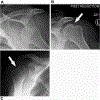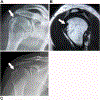Mimickers of Hill-Sachs Lesions
- PMID: 32063021
- PMCID: PMC7415664
- DOI: 10.1177/0846537119895751
Mimickers of Hill-Sachs Lesions
Abstract
The purpose of this article is to describe the imaging appearance, etiology, clinical features, and treatment of rare presentations of common bone and joint diseases known to mimic Hill-Sachs lesions. Knowledge of uncommonly encountered manifestations of ankylosing spondylitis, rheumatoid arthritis, septic joint, hyperparathyroidism, hydroxyapatite deposition disease, malignant bone tumors, and benign bone cysts which mimic traumatic Hill-Sachs lesions is important for radiologists to guide the clinical care of patients who present with shoulder symptoms.
Keywords: Hill-Sachs lesion; hatchet sign; humerus; imaging; mimicker; shoulder.
Figures










References
-
- Jin W, Ryu KN, Park YK, Lee WK, Ko SH, Yang DM. Cystic lesions in the posterosuperior portion of the humeral head on MR arthrography: correlations with gross and histologic findings in cadavers. AJR Am J Roentgenol 2005; 184:1211–1215 - PubMed
-
- Jacobson JA, Girish G, Jiang Y, Resnick D. Radiographic evaluation of arthritis: inflammatory conditions. Radiology 2008; 248:378–389 - PubMed
-
- Sandstrom CK, Kennedy SA, Gross JA. Acute shoulder trauma: what the surgeon wants to know. Radiographics 2015; 35:475–492 - PubMed
Publication types
MeSH terms
Grants and funding
LinkOut - more resources
Full Text Sources
Medical
Research Materials

